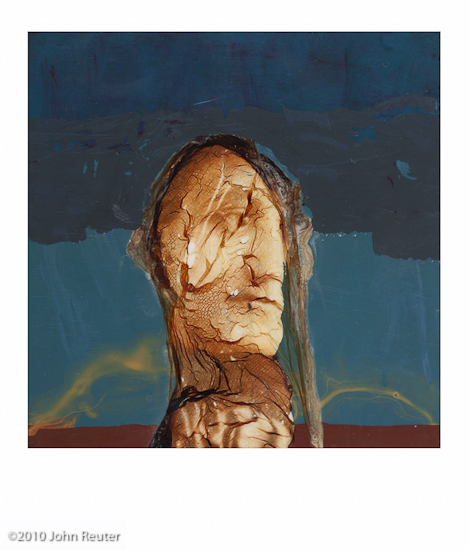Artists include: Laura Blacklow, Paul Caponigro, Ellen Carey, Bobbi Carri, Marie Cosindas, Alma Davenport, Elsa Dorfman, Olivia Parker, Rosamond Purcell, John Reuter, Jim Stone and Jane Tuckerman
The exhibit runs from July 31-September 6, 2010. There’s an opening reception on July 31 from 4-7pm
John Reuter will be exhibiting 12 SX-70 Constructions that have not been seen in a gallery or museum for over thirty years. These jewel like images are constructions of photography, collage and painting all assembled in the tiny 3 1/8 inch square of the SX-70 frame.
Gallery 4 is located at 3848 Main Road in Tiverton 4 Corners, RI.
Telephone 401-816-0999. www.gallery4tiverton.com
Hours Mon-Thurs 10-5, Sun 12-5
SX-70 Constructions 1975-1980
All artists and photographers react to technology. Whether that technology is traditional such as oil paint and canvas or contemporary digital technology that pushes the envelope of representation the artist has a relationship to that technology that shapes their work. I was privileged to interact with a new instant photographic process in the mid-1970s that not only shaped my aesthetic, but ultimately my career. In 1975 I was in between my undergraduate and graduate studies in photography at the State University of New York at Geneseo and the University of Iowa School of At and Art History in Iowa City. I had followed a path of experimental photography inspired by my professors Michael and Rosemary Teres at Geneseo. Both had studied at Hunter College in New York and the University of Iowa in the 1960s, a period of experimentation in process and conceptual art. By the 1970s photography was also very experimental with an emphasis on long lost non-silver techniques such as cyanotype, Van Dyke Brown, gum printing, Quick Print as well as contemporary technologies such as Xerox, solvent transfer, and printmaking techniques such as silk screen and lithography. Michael and Rosemary inspired me to explore all of these avenues and Rosemary inspired me further as one of my Art History teachers. Perhaps more importantly she allowed me to combine photography and painting in her painting classes and while my experiments then were rudimentary it laid the groundwork for what was to come.
My work in the early 70’s explored many black and white processes such as solarization, multiple printing, reticulation as well as the aforementioned non-silver processes. My use of painting was tentative; I had had no training and certainly had no encouragement as a painter. Throughout this period most but not all of my influences were in fact painters, from Rene Magritte, Salvador Dali, Max Ernst, Yves Tanguy, Francis Bacon and experimental photographers such as Herbert Bayer, Maholy Nagy, and Man Ray.
John Reuter, meet Polaroid SX-70. Edwin Land and Polaroid introduced the Polaroid SX-70 in 1972. A revolutionary photographic technology, it began to appeal to art photographers almost immediately. Perhaps the most prominent was Lucas Samaras, a painter/photographer/sculptor/installation artist. His “Auto-Transformations” was an absolute tour de force. I had already been a fan of Samaras’ Auto-Polaroids , images he made and manipulated with Polaroid peel apart film. I was given an SX-70 by my family in 1974 and at first was unsure what to do with it. The film was expensive so I dabbled initially. My first images were photographed off of network television, soap operas, news shows and I performed surface manipulations on them a la Samaras. That was about it until I arrived at the University of Iowa. My decision to attend Iowa was a complicated one. My professor at Geneseo, Michael Teres had attended there and I met John Schulze, the head of the program at Iowa in 1974 when he visited Geneseo. I later attended an SPE conference in Iowa and was convinced that this was where I wanted to do my graduate studies. In the fall of 1975 I was feeling my way in the department. The program was large, 35 graduate students and competition was intense. I was invited to participate in a figure photo shoot by Rick Valicenti, a fellow student, and we both pulled out our SX-70 cameras at the shoot. He later showed me a technique we later referred to as “emulsion stripping”. To describe briefly, emulsion stripping involved this process: an image is photographed, exits the camera, evaluated for exposure and set aside to cure for 6-8 hours. The curing was necessary because this film was an “integral” product, and as such needed time to set inside the film “envelope” as opposed to the former “peel apart” product that was separated after 60 seconds. Integral film did not peel and its amalgam of chemicals and dyes needed time to settle, cure, and ultimately dry. By carefully cutting the negative from the back of the film unit, you could reveal the still pliable positive emulsion and dyes. These dyes were coated with titanium dioxide, found in white paint, which gave opacity to the actually transparent dyes attached to the positive layer. Placing the image on a light table revealed the contour of the image. By carefully cutting the outlines of the image you could then remove portions of the dyes, leaving clear polyester in their place. Working from behind, I would then paint or collage around the remaining figure in the frame. The buildup would be details first, middle ground second and background last. Within a year I developed a second technique, which I dubbed an emulsion transfer. This differed greatly in technique from emulsion stripping. In this case I began to work on the image almost immediately after it exited from the camera. I would cut all four sides of the film packet and strip the negative away. I would place the remaining positive in a vessel of hot water, and rub off the titanium dioxide rendering the positive layer transparent. After soaking for about a minute I would place the positive dye side down on watercolor paper and rub on the polyester surface, pushing the dyes into the fibers of the paper. I could then peel up the polyester layer, leaving the dyes on the paper. From here I might cut the image to remove unwanted parts and shape the image with a watercolor brush. I would then take an empty SX-70 frame with the polyester and signature white border (cleared out ahead of time form a reject image) and coat the dyes with acrylic gel medium, which actually is a very good glue. Hovering the empty SX-70 frame over the dyes for position I would then place it over the image and pick it up into the empty frame. Once dry I would paint the back of the dyes with white paint to restore opacity and work the image much in the way I did with the emulsion stripped images. To me the distortion of the transferred dyes added an element of strangeness to the image, which fit well into my surrealist aesthetic. At times I would transfer both a figure and a background into a new frame. I worked with these techniques for nearly five years, finally stopping when Polaroid changed the makeup of the film, in their minds “improving” it. Reacting to competition from Kodak, who entered the market with their own instant integral product in 1976, Polaroid made the dyes thinner and faster developing and most importantly moving a release layer once on the positive to the negative side. These changes rendered the emulsion transfer impossible and the emulsion stripping much more difficult. By this time, 1980 I was working at Polaroid as a research photographer. I could have hoarded a substantial amount of the older film and I did to some extent. In some ways I felt the work had had its run and it was time to move on. Within a year I was concentrating on the image transfer process in 8×10 format and eventually 20×24.



.jpg)














